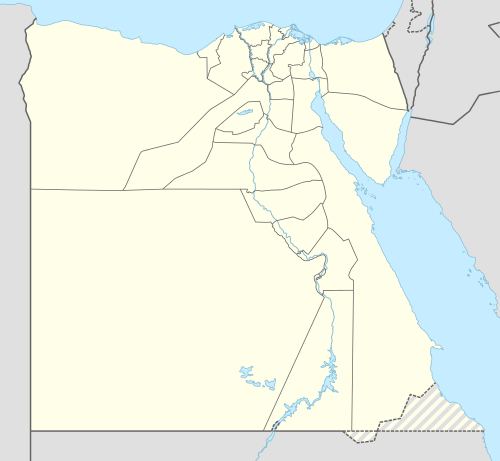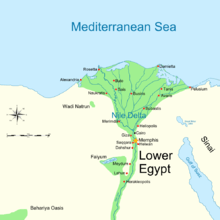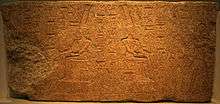Bubastis
| Βούβαστις | |
|
View of Bubastis | |
 Shown within Egypt | |
| Alternate name |
Bubastis Per-Bast |
|---|---|
| Location | Tell-Basta, Sharqia Governorate, Egypt |
| Region | Lower Egypt |
| Coordinates | 30°34′22″N 31°30′36″E / 30.57278°N 31.51000°ECoordinates: 30°34′22″N 31°30′36″E / 30.57278°N 31.51000°E |
| Type | Settlement |
| Site notes | |
| Condition | In ruins |

| ||||
| Bubastis in hieroglyphs |
|---|
Bubastis (Greek: Βούβαστις Boubastis[1] or Βούβαστος Boubastos[2]), also known in Arabic as Tell-Basta or in Egyptian as Per-Bast, was an Ancient Egyptian city. It was the capital of its own nome, located along the River Nile in the Delta region of Lower Egypt. Bubastis is often identified with the biblical Phibeseth (Hebrew פי-בסת PY-BST, Ezekiel 30:17).[3]
Etymology
The name of Bubastis in Egyptian is Pr-Bȝśt.t, typically transcribed Per-Bast. PR means "house" and the second word is the name of the goddess Bast or Bastet. The phrase means "House of Bast".[4]
History

Bubastis served as the capital of the nome of Am-Khent, the Bubastite nome, the 18th nome of Lower Egypt. Bubastis was situated southwest of Tanis, upon the eastern side of the Pelusiac branch of the Nile. The nome and city of Bubastis were allotted to the Calasirian division of the Egyptian war-caste.
It became a royal residence after Shoshenq I, the first ruler and founder of the 22nd dynasty, became pharaoh in 943 BC. Bubastis was its height during this dynasty and the 23rd. It declined after the Persian conquest by Cambyses II in 525 BC, which heralded the end of the Saite 26th dynasty and the start of the Achaemenid dynasty.
The Twenty Second Dynasty of Egyptian monarchs consisted of nine, or, according to Eusebius[5] of three Bubastite kings, and during their reigns the city was one of the most considerable places in the Delta. Immediately to the south of Bubastis were the allotments of land with which Psammetichus rewarded the services of his Ionian and Carian mercenaries;[6] and on the northern side of the city commenced the canal which Pharaoh Necho II began (but never finished) to go between the Nile and the Red Sea.[7] After Bubastis was taken by the Persians, its walls were dismantled.[8] From this period it gradually declined, although it appears in ecclesiastical annals among the episcopal sees of the province Augustamnica Secunda. Bubastite coins of the age of Hadrian exist.
The following is the description which Herodotus gives of Bubastis, as it appeared shortly after the period of the Persian invasion, 525 BC, and Hamilton remarks that the plan of the ruins remarkably warrants the accuracy of this historical eye-witness.[9]
"Temples there are more spacious and costlier than that of Bubastis, but none so pleasant to behold. It is after the following fashion. Except at the entrance, it is surrounded by water: for two canals branch off from the river, and run as far as the entrance to the temple: yet neither canal mingles with the other, but one runs on this side, and the other on that. Each canal is a hundred feet wide, and its banks are lined with trees. The propylaea are sixty feet in height, and are adorned with sculptures (probably intaglios in relief) nine feet high, and of excellent workmanship. The Temple being in the middle of the city is looked down upon from all sides as you walk around; and this comes from the city having been raised, whereas the temple itself has not been moved, but remains in its original place. Quite round the temple there goes a wall, adorned with sculptures. Within the inclosure is a grove of fair tall trees, planted around a large building in which is the effigy (of Bast). The form of that temple is square, each side being a stadium in length. In a line with the entrance is a road built of stone about three stadia long, leading eastwards through the public market. The road is about 400 feet (120 m) broad, and is flanked by exceeding tall trees. It leads to the temple of Hermes."
Religion

Bubastis was a center of worship for the feline goddess Bast (also called Bastet (emphasising the feminine ending t), or even Bubastis (after the city)), which the ancient Greeks identified with Artemis. The cat was the sacred and peculiar animal of Bast, who is represented with the head of a cat or a lioness and frequently accompanies the deity Ptah in monumental inscriptions. The tombs at Bubastis were accordingly the principal depository in Egypt of the mummies of the cat.
The most distinguished features of the city and nome of Bubastis were its oracle of Bast, the splendid temple of that goddess and the annual procession in honor of her. The oracle gained in popularity and importance after the influx of Greek settlers into the Delta, since the identification of Bast with Artemis attracted to her shrine both native Egyptians and foreigners.
The festival of Bubastis was the most joyous and gorgeous of all in the Egyptian calendar as described by Herodotus:
"Barges and river craft of every description, filled with men and women, floated leisurely down the Nile. The men played on pipes of lotus. the women on cymbals and tambourines, and such as had no instruments accompanied the music with clapping of hands and dances, and other joyous gestures. Thus did they while on the river: but when they came to a town on its banks, the barges were made fast, and the pilgrims disembarked, and the women sang, playfully mocked the women of that town and threw their clothes over their head. When they reached Bubastis, then held they a wondrously solemn feast: and more wine of the grape was drank in those days than in all the rest of the year. Such was the manner of this festival: and, it is said, that as many as seven hundred thousand pilgrims have been known to celebrate the Feast of Bast at the same time."[11]
Christian bishopric
Extant documents mention the names of three Christian bishops of Bubastis of the 4th and 5th centuries:
- Harpocration, one of the bishops ordained by Meletius of Lycopolis listed in 325
- Hermon, a contemporary of Saint Athanasius, in about 362
- Iulianus at the Robber Council of Ephesus in 449[12][13][14]
Excavations
The tomb of the late New Kingdom vizier Iuty was discovered in December 1964 in the "Cemetery of the Nobles" of Bubastis by the Egyptian archaeologist Shafik Farid.
Since 2008, the German-Egyptian "Tell Basta Project" has been conducting excavations at Bubastis. Previously, in March 2004, a well preserved copy of the Decree of Canopus was discovered in the city.[15]
References
| Wikisource has the text of the 1911 Encyclopædia Britannica article Bubastis. |
- ↑ Herod. ii. 59, 137
- ↑ Strabo xvii. p. 805, Diodorus xvi. 51, Plin. v. 9. s. 9, Ptol. iv. 5. § 52.
- ↑ Ezek. 30:17. בחורי און ופי-בסת, בחרב יפלו; והןה, בשבי תלכןה. "Youths of Awen and Pi-Beset will fall by the sword; and they (fem) will go into captivity." הןה "they (feminine)" cannot refer to the youths, and so must refer to the cities. Hebrew words meaning "city" are generally feminine (עיר, קריה).
- ↑ Mohamed I. Bakr, Helmut Brandl, "Bubastis and the Temple of Bastet", in: M.I. Bakr, H. Brandl, F. Kalloniatis (eds.), Egyptian Antiquities from Kufur Nigm and Bubastis. Museums in the Nile Delta Archived January 8, 2015, at the Wayback Machine. (M.i.N.) vol. 1, Cairo/ Berlin 2010, pp. 27-36, ISBN 978-3-00-033509-9.
- ↑ Chronicon
- ↑ Herod. ii. 154
- ↑ Herod. ii. 158
- ↑ Diod. xvi. 51.
- ↑ Herod. ii. 59, 60.
- ↑ British Museum Collection
- ↑
 Smith, William, ed. (1854–1857). "Bubastis". Dictionary of Greek and Roman Geography. London: John Murray. Retrieved 2012-01-28.
Smith, William, ed. (1854–1857). "Bubastis". Dictionary of Greek and Roman Geography. London: John Murray. Retrieved 2012-01-28. - ↑ Pius Bonifacius Gams, Series episcoporum Ecclesiae Catholicae, Leipzig 1931, p. 461
- ↑ Michel Lequien, Oriens christianus in quatuor Patriarchatus digestus, Paris 1740, Vol. II, coll. 559-562
- ↑ Klaas A. Worp, A Checklist of Bishops in Byzantine Egypt (A.D. 325 - c. 750), in Zeitschrift für Papyrologie und Epigraphik 100 (1994) 283-318
- ↑ Tell Basta Project (EES/ University of Göttingen/ SCA) Egypt Exploration Society
External links
| Wikimedia Commons has media related to Bubastis. |
- Tell Basta Project (EES/ University of Göttingen/ SCA) Egypt Exploration Society
- Preliminary German website of Tell Basta Project
- Finds from Bubastis on the website of MUSEUMS IN THE NILE DELTA (project M.i.N.)
 This article incorporates text from a publication now in the public domain: Smith, William, ed. (1854–1857). "Bubastis". Dictionary of Greek and Roman Geography. London: John Murray.
This article incorporates text from a publication now in the public domain: Smith, William, ed. (1854–1857). "Bubastis". Dictionary of Greek and Roman Geography. London: John Murray.
